Buick LaCrosse 2012 User Manual

2012 Buick LaCrosse Owner Manual M
In Brief . . . . . . . . . . . . . . . . . . . . . . . . 1-1
Instrument Panel . . . . . . . . . . . . . . 1-2
Initial Drive Information . . . . . . . . 1-4
Vehicle Features . . . . . . . . . . . . . 1-17
eAssist Features . . . . . . . . . . . . . 1-22
Performance and
Maintenance . . . . . . . . . . . . . . . . 1-25
Keys, Doors, and
Windows . . . . . . . . . . . . . . . . . . . . 2-1
Keys and Locks . . . . . . . . . . . . . . . 2-2
Doors . . . . . . . . . . . . . . . . . . . . . . . . 2-12
Vehicle Security. . . . . . . . . . . . . . 2-13
Exterior Mirrors . . . . . . . . . . . . . . . 2-16
Interior Mirrors . . . . . . . . . . . . . . . . 2-17
Windows . . . . . . . . . . . . . . . . . . . . . 2-18
Roof . . . . . . . . . . . . . . . . . . . . . . . . . . 2-21
Seats and Restraints . . . . . . . . . 3-1
Head Restraints . . . . . . . . . . . . . . . 3-2
Front Seats . . . . . . . . . . . . . . . . . . . . 3-4
Rear Seats . . . . . . . . . . . . . . . . . . . 3-11
Safety Belts . . . . . . . . . . . . . . . . . . 3-13
Airbag System . . . . . . . . . . . . . . . . 3-21
Child Restraints . . . . . . . . . . . . . . 3-34
Storage . . . . . . . . . . . . . . . . . . . . . . . 4-1
Storage Compartments . . . . . . . . 4-1
Additional Storage
Features . . . . . . . . . . . . . . . . . . . . . 4-3
Instruments and Controls . . . . 5-1
Controls . . . . . . . . . . . . . . . . . . . . . . . 5-2
Warning Lights, Gauges, and
Indicators . . . . . . . . . . . . . . . . . . . . 5-8
Information Displays . . . . . . . . . . 5-25
Vehicle Messages . . . . . . . . . . . . 5-33
Vehicle Personalization . . . . . . . 5-40
Universal Remote System . . . . 5-46
Lighting . . . . . . . . . . . . . . . . . . . . . . . 6-1
Exterior Lighting . . . . . . . . . . . . . . . 6-2
Interior Lighting . . . . . . . . . . . . . . . . 6-6
Lighting Features . . . . . . . . . . . . . . 6-7
Infotainment System . . . . . . . . . 7-1
Introduction . . . . . . . . . . . . . . . . . . . . 7-2
Radio . . . . . . . . . . . . . . . . . . . . . . . . . 7-17
Audio Players . . . . . . . . . . . . . . . . 7-26
Rear Seat Infotainment . . . . . . . 7-47
Phone . . . . . . . . . . . . . . . . . . . . . . . . 7-57
Trademarks and License
Agreements . . . . . . . . . . . . . . . . . 7-81
Climate Controls . . . . . . . . . . . . . 8-1
Climate Control Systems . . . . . . 8-1
Air Vents . . . . . . . . . . . . . . . . . . . . . . . 8-9
Maintenance . . . . . . . . . . . . . . . . . 8-10
Driving and Operating . . . . . . . . 9-1
Driving Information . . . . . . . . . . . . . 9-2
Starting and Operating . . . . . . . 9-15
Engine Exhaust . . . . . . . . . . . . . . 9-28
Automatic Transmission . . . . . . 9-29
Drive Systems . . . . . . . . . . . . . . . . 9-32
Brakes . . . . . . . . . . . . . . . . . . . . . . . 9-33

2012 Buick LaCrosse Owner Manual M
Ride Control Systems . . . . . . . . 9-36
Cruise Control . . . . . . . . . . . . . . . . 9-40
Object Detection Systems . . . . 9-42
Fuel . . . . . . . . . . . . . . . . . . . . . . . . . . 9-49
Towing . . . . . . . . . . . . . . . . . . . . . . . 9-54
Conversions and Add-Ons . . . 9-60
Vehicle Care . . . . . . . . . . . . . . . . . 10-1
General Information . . . . . . . . . . 10-3
Vehicle Checks . . . . . . . . . . . . . . . 10-4
Headlamp Aiming . . . . . . . . . . . 10-28
Bulb Replacement . . . . . . . . . . 10-31
Electrical System . . . . . . . . . . . . 10-35
Wheels and Tires . . . . . . . . . . . 10-44
Jump Starting . . . . . . . . . . . . . . . 10-90
Towing . . . . . . . . . . . . . . . . . . . . . . 10-94
Appearance Care . . . . . . . . . . . 10-98
Service and Maintenance . . . 11-1
General Information . . . . . . . . . . 11-1
Maintenance Schedule . . . . . . . 11-3
Special Application
Services . . . . . . . . . . . . . . . . . . . . 11-9
Additional Maintenance
and Care . . . . . . . . . . . . . . . . . . . 11-10
Recommended Fluids,
Lubricants, and Parts . . . . . . 11-14
Maintenance Records . . . . . . . 11-17
Technical Data . . . . . . . . . . . . . . . 12-1
Vehicle Identification . . . . . . . . . 12-1
Vehicle Data . . . . . . . . . . . . . . . . . . 12-2
Customer Information . . . . . . . 13-1
Customer Information . . . . . . . . 13-1
Reporting Safety Defects . . . . 13-17
Vehicle Data Recording
and Privacy. . . . . . . . . . . . . . . . 13-18
OnStar . . . . . . . . . . . . . . . . . . . . . . . 14-1
OnStar Overview. . . . . . . . . . . . . 14-1
OnStar Services . . . . . . . . . . . . . . 14-2
OnStar Additional
Information . . . . . . . . . . . . . . . . . . 14-5
Index . . . . . . . . . . . . . . . . . . . . . i-1
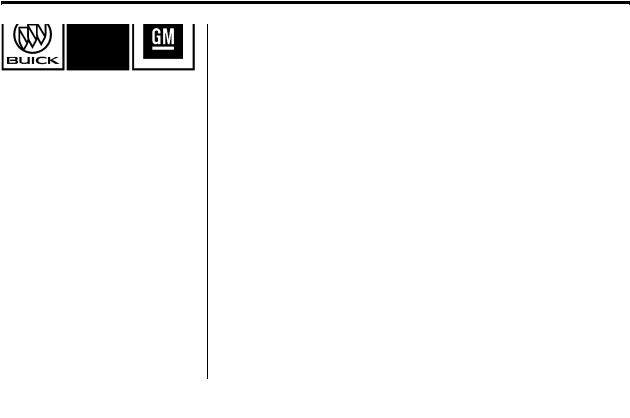
Introduction iii
The names, logos, emblems, slogans, vehicle model names, and vehicle body designs appearing in this manual including, but not limited to, GM, the GM logo, BUICK, the BUICK Emblem, and LACROSSE are trademarks and/or service marks of General Motors LLC, its subsidiaries, affiliates, or licensors.
This manual describes features that may or may not be on your specific vehicle either because they are options that you did not purchase or due to changes subsequent to the printing of this owner manual. Please refer to the purchase documentation relating to your specific vehicle to confirm each of the features found on your vehicle. For vehicles first sold in Canada, substitute the name “General Motors of Canada Limited” for Buick Motor Division wherever it appears in this manual.
Keep this manual in the vehicle for quick reference.
Canadian Vehicle Owners
Propriétaires Canadiens
A French language copy of this manual can be obtained from your dealer or from:
On peut obtenir un exemplaire de ce guide en français auprès du concessionnaire ou à l'adresse suivante:
Helm, Incorporated
P.O. Box 07130
Detroit, MI 48207
1-800-551-4123
Numéro de poste 6438 de langue française
www.helminc.com
Litho in U.S.A. |
© 2011 General Motors LLC. All Rights Reserved. |
Part No. 20867287 A First Printing |

iv Introduction
Using this Manual
To quickly locate information about the vehicle, use the Index in the back of the manual. It is an alphabetical list of what is in the manual and the page number where it can be found.
Danger, Warnings, and
Cautions
Warning messages found on vehicle labels and in this manual describe hazards and what to do to avoid or reduce them.
Danger indicates a hazard with a high level of risk which will result in serious injury or death.
Warning or Caution indicates a hazard that could result in injury or death.
{WARNING
These mean there is something that could hurt you or other people.
Notice: This means there is something that could result in property or vehicle damage. This would not be covered by the vehicle's warranty.
A circle with a slash through it is a safety symbol which means “Do Not,” “Do not do this,” or “Do not let this happen.”
Symbols
The vehicle has components and labels that use symbols instead of text. Symbols are shown along with the text describing the operation or information relating to a specific component, control, message, gauge, or indicator.
M : This symbol is shown when you need to see your owner manual for additional instructions or information.
* : This symbol is shown when you need to see a service manual for additional instructions or information.

Introduction v
Vehicle Symbol Chart
Here are some additional symbols that may be found on the vehicle and what they mean. For more information on the symbol, refer to the Index.
9 : Airbag Readiness Light
# : Air Conditioning
! : Antilock Brake System (ABS)
% : Audio Steering Wheel Controls or OnStar®
$ : Brake System Warning Light
" : Charging System |
* : |
Malfunction Indicator Lamp |
|
I : |
Cruise Control |
: : |
Oil Pressure |
B : |
Engine Coolant Temperature |
} : |
Power |
O : |
Exterior Lamps |
/ : |
Remote Vehicle Start |
# : |
Fog Lamps |
> : |
Safety Belt Reminders |
. : |
Fuel Gauge |
7 : |
Tire Pressure Monitor |
+ : |
Fuses |
d : |
Traction Control/Stabilitrak® |
3 : |
Headlamp High/Low-Beam |
M : |
Windshield Washer Fluid |
Changer
j : LATCH System Child
Restraints

vi Introduction
2 NOTES

In Brief |
1-1 |
In Brief
Instrument Panel
Instrument Panel . . . . . . . . . . . . . . 1-2
Initial Drive Information
Initial Drive Information . . . . . . . . 1-4
Remote Keyless Entry (RKE)
System . . . . . . . . . . . . . . . . . . . . . . 1-4
Remote Vehicle Start . . . . . . . . . 1-4
Door Locks . . . . . . . . . . . . . . . . . . . 1-5
Trunk Release . . . . . . . . . . . . . . . . 1-6
Windows . . . . . . . . . . . . . . . . . . . . . . 1-6
Seat Adjustment . . . . . . . . . . . . . . 1-6
Memory Features . . . . . . . . . . . . . 1-8
Heated and Ventilated
Seats . . . . . . . . . . . . . . . . . . . . . . . . 1-9
Head Restraint Adjustment . . . . 1-9
Safety Belts . . . . . . . . . . . . . . . . . . 1-10
Passenger Sensing
System . . . . . . . . . . . . . . . . . . . . . 1-10
Mirror Adjustment . . . . . . . . . . . . 1-10
Steering Wheel
Adjustment . . . . . . . . . . . . . . . . . 1-11
Interior Lighting . . . . . . . . . . . . . . 1-12
Exterior Lighting . . . . . . . . . . . . . 1-12
Windshield Wiper/Washer . . . . 1-13
Climate Controls . . . . . . . . . . . . . 1-14
Transmission . . . . . . . . . . . . . . . . 1-16
Vehicle Features
Radio(s) . . . . . . . . . . . . . . . . . . . . . 1-17
Satellite Radio . . . . . . . . . . . . . . . 1-18
Portable Audio Devices . . . . . . 1-18
Bluetooth® . . . . . . . . . . . . . . . . . . . 1-18
Steering Wheel Controls . . . . . 1-19
Cruise Control . . . . . . . . . . . . . . . 1-19
Navigation System . . . . . . . . . . . 1-20
Driver Information
Center (DIC) . . . . . . . . . . . . . . . 1-20
Vehicle Personalization . . . . . . 1-21
Ultrasonic Parking Assist . . . . 1-21
Power Outlets . . . . . . . . . . . . . . . 1-21
Universal Remote System . . . 1-21
Sunroof . . . . . . . . . . . . . . . . . . . . . . 1-22
eAssist Features
eAssist® Overview . . . . . . . . . . . 1-22
High Voltage Safety
Information . . . . . . . . . . . . . . . . . 1-23
Driver Efficiency Gauge . . . . . . 1-23
Automatic Engine Start/Stop
Feature . . . . . . . . . . . . . . . . . . . . . 1-24
Regenerative Braking . . . . . . . . 1-24
Battery . . . . . . . . . . . . . . . . . . . . . . . 1-24
Service . . . . . . . . . . . . . . . . . . . . . . 1-25
Performance and Maintenance
Traction Control
System (TCS) . . . . . . . . . . . . . . 1-25 StabiliTrak® System . . . . . . . . . 1-25 Tire Pressure Monitor . . . . . . . . 1-26 Tire Sealant and
Compressor Kit . . . . . . . . . . . . . 1-26 Engine Oil Life System . . . . . . 1-26 Driving for Better Fuel
Economy . . . . . . . . . . . . . . . . . . . 1-27 Roadside Assistance
Program . . . . . . . . . . . . . . . . . . . . 1-27 OnStar® . . . . . . . . . . . . . . . . . . . . . 1-28
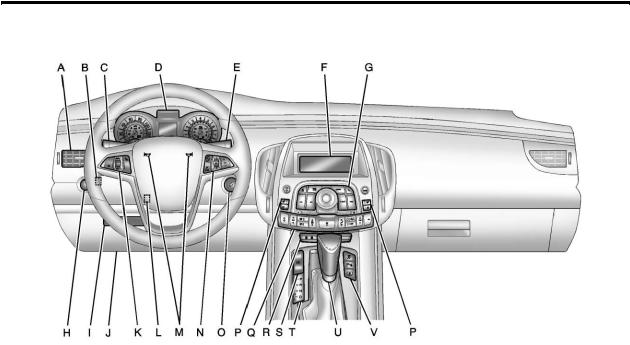
1-2 In Brief
Instrument Panel

In Brief |
1-3 |
A.Air Vents on page 8 9.
B.Head-Up Display (HUD) on page 5 29 (If Equipped).
C.Turn and Lane Change Lever. See Turn and Lane-Change Signals on page 6 4.
Driver Information Center Buttons. See Driver Information Center (DIC) on page 5 25.
D.Instrument Cluster on page 5 9.
Driver Information Center Display. See Driver Information Center (DIC) on page 5 25.
E.Windshield Wiper/Washer on page 5 3.
F.Infotainment Display Screen.
G.Infotainment on page 7 2.
H.Exterior Lamp Controls on page 6 2.
Fog Lamps on page 6 5
(If Equipped).
Instrument Panel Illumination Control on page 6 6.
I.Front Storage on page 4 2.
J.Data Link Connector (DLC) (Out of View). See Malfunction Indicator Lamp on page 5 16.
K.Cruise Control on page 9 40.
L.Steering Wheel Adjustment on page 5 2.
M.Horn on page 5 3.
N.Steering Wheel Controls on page 5 2 (If Equipped).
O.Ignition Positions (Key Access) on page 9 16 or Ignition Positions (Keyless Access) on page 9 18.
P.Heated and Ventilated Front Seats on page 3 10
(If Equipped).
Q.Automatic Climate Control System on page 8 1
(If Equipped).
Dual Automatic Climate Control System on page 8 4
(If Equipped).
R.Power Door Locks on page 2 11.
Hazard Warning Flashers on page 6 4.
Passenger Sensing System on page 3 27.
S.Parking Brake on page 9 34.
T.Shift Lever Position Indicator. See Automatic Transmission on page 9 29.
U.Shift Lever. See Shifting Into Park on page 9 25.
V.Traction Control System (TCS) on page 9 36.
StabiliTrak® System on page 9 37 (If Equipped).
Ultrasonic Parking Assist on page 9 42.
Rear Window Sunshade on page 2 20 (If Equipped).

1-4 In Brief
Initial Drive
Information
This section provides a brief overview about some of the important features that may or may not be on your specific vehicle.
For more detailed information, refer to each of the features which can be found later in this owner manual.
Remote Keyless Entry
(RKE) System
The Remote Keyless Entry (RKE) transmitter will work up to 20 m (65 ft) away from the vehicle. On vehicles with remote start the distance will be greater.
Press the button to extend the key. The key can be used for all locks. This key is also used for the ignition, if the vehicle does not have pushbutton start.
K : Press to unlock the driver door or all doors.
Q : Press to lock all doors.
Lock and unlock feedback can be personalized.
V: Press and hold to open the trunk.
7 : Press and release one time to locate the vehicle. Press and hold for at least two seconds to sound the panic alarm. Press again to cancel the panic alarm.
See Keys on page 2 2 and Remote Keyless Entry (RKE) System Operation on page 2 3.
Remote Vehicle Start
For vehicles with this feature, the engine can be started from outside the vehicle.
Starting the Vehicle
1.Aim the RKE transmitter at the vehicle.
2.Press and release Q.
3.Immediately after completing Step 2, press and hold / until the turn signal lamps flash, or for about two seconds if the vehicle is not in view.

In Brief |
1-5 |
When the engine starts, the parking lamps will turn on and remain on as long as the engine is running. The doors will be locked and the climate control system may come on.
The engine will continue to run for 10 minutes. Repeat the steps for a 10-minute time extension. Remote start can be extended only once.
Canceling a Remote Start
To cancel a remote start, do one of the following:
.Aim the RKE transmitter at the vehicle and press and hold / until the parking lamps turn off.
.Turn on the hazard warning flashers.
.Turn the vehicle on and then off.
See Remote Vehicle Start on page 2 8.
Door Locks
To lock or unlock the doors:
.From inside the vehicle, use the door lock knob or the power door lock controls, pull once on the door handle to unlock it, and a second time to open it.
.From outside, use the key,
or press Q or K on the Remote Keyless Entry (RKE) transmitter. See Remote Keyless Entry (RKE) System Operation on page 2 3.
See Door Locks on page 2 10.
Power Door Locks
K : Press to unlock the doors.
Q : Press to lock the doors.
See Power Door Locks on page 2 11.

1-6 In Brief
Trunk Release
The trunk may be opened by pressing Von the Remote Keyless Entry (RKE) transmitter or the touch pad located on the rear of the trunk above the license plate. See Trunk on page 2 12 for more information.
Windows
Press the switch to lower the window. Pull the switch up to raise it.
For more information, see Power Windows on page 2 19.
Seat Adjustment
Manual Seats
A.Seatback Recline Lever
B.Height Adjustment Switch
C.Seat Position Handle
To adjust the seat position:
1.Pull the handle (C) under the front of the seat cushion.
2.Slide the seat to the desired position and release the handle.
3.Try to move the seat back and forth to be sure it is locked in place.
Press and hold the top or bottom of the switch (B) to raise or lower the seat. Release the switch when the desired height is reached.
To raise or recline the seatback, use the lever (A) on the outboard side of the seat.
See Seat Adjustment on page 3 4 and Reclining Seatbacks on page 3 6 for more information.

In Brief |
1-7 |
Power Seats
To adjust the seat:
.Move the seat forward or rearward by moving the horizontal control forward or rearward.
.Raise or lower the front or rear part of the seat cushion by moving the front or rear of the horizontal control up or down.
.Raise or lower the entire seat by moving the control up or down.
See Power Seat Adjustment on page 3 5.
Power Reclining Seatbacks
To raise or recline the seatback, tilt the top of the vertical control forward or rearward. See Reclining Seatbacks on page 3 6.
Lumbar Adjustment
To adjust the lumbar support, if available:
.Press and hold the front or rear of the control to increase or decrease lumbar support.
.Press and hold the top or bottom of the control to raise or lower lumbar support.
See Lumbar Adjustment on page 3 5.
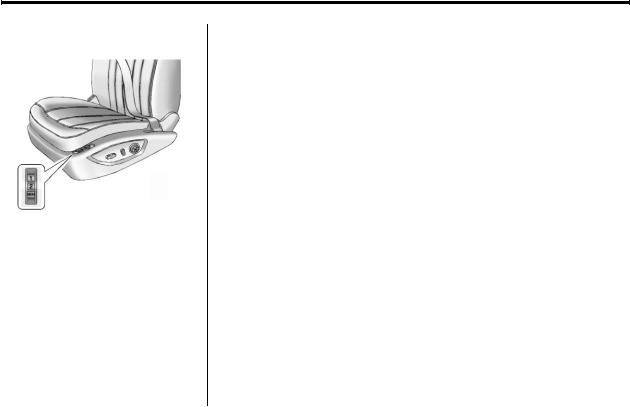
1-8 In Brief
Memory Features
On vehicles with the memory feature, the “1” and “2” buttons on the outboard side of the driver seat are used to manually save and recall the driver seat and outside mirror positions. These manually stored positions are referred to as Button Memory positions.
The vehicle will also automatically save driver seat and outside mirror positions to the current driver Remote Keyless Entry (RKE) transmitter when the ignition is placed in OFF. These automatically stored positions are referred to as RKE Memory positions.
Storing Button Memory Positions
To save positions into Button Memory:
1.Adjust the driver seat, seatback recliner, and both outside mirrors to the desired driving positions.
2.Press and hold MEM (Memory) and “1” at the same time until a beep sounds.
3.Repeat Steps 1 and 2 for a second driver using “2.”
To recall the manually saved Button Memory positions, press and hold “1” or “2.” The driver seat and outside mirrors move to the positions stored to those buttons
when pressed. Releasing “1” or “2” before the stored positions are reached stops the recall.
To automatically recall RKE Memory positions, unlock the driver door with the RKE transmitter, and open the driver door. On vehicles with Keyless Access, opening the driver door when an RKE transmitter is present will activate the RKE Memory recall. If the driver door is already open, pressing the RKE transmitter K button will also activate the RKE Memory recall. The driver seat and outside mirrors will move to the previously saved RKE Memory positions.
See Memory Seats on page 3 7 for more information.

In Brief |
1-9 |
Easy Exit Driver Seat
This feature moves the seat rearward allowing the driver more room to exit the vehicle.
To activate, place the ignition in OFF and open the driver door. If the driver door is already open, placing the ignition in OFF will activate the easy exit driver seat.
This feature is turned on or off using the vehicle personalization menu. See “Driver Seat Easy Exit” under
Vehicle Personalization on page 5 40 for more information.
Heated and Ventilated
Seats
Heated and Ventilated Seat
Buttons Shown, Heated Seat
Buttons Similar
If available, the buttons are on the climate control panel. To operate, the ignition must be on.
Press L to heat the seat cushion
and seatback or {, if equipped, to ventilate the seat.
Press the button once for the highest setting. With each press of the button, the seat will change to the next lower setting, and then to the off setting. The lights indicate three for the highest setting and one for the lowest.
For more information, see Heated and Ventilated Front Seats on page 3 10.
Head Restraint
Adjustment
Do not drive until the head restraints for all occupants are installed and adjusted properly.
To achieve a comfortable seating position, change the seatback recline angle as little as necessary while keeping the seat and the head restraint height in the proper position.
For more information see Head Restraints on page 3 2 and Seat Adjustment on page 3 4.
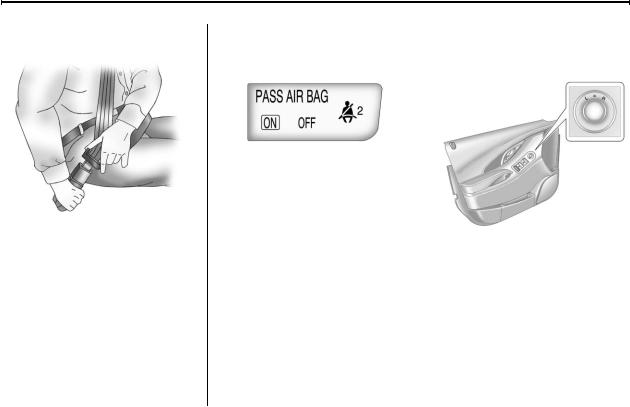
1-10 |
In Brief |
Safety Belts |
Passenger Sensing |
Mirror Adjustment |
|
System |
Exterior |
|
|
Refer to the following sections for important information on how to use safety belts properly:
.Safety Belts on page 3 13.
.How to Wear Safety Belts Properly on page 3 14.
.Lap-Shoulder Belt on page 3 15.
.Lower Anchors and Tethers for Children (LATCH System) on page 3 42.
The passenger sensing system turns off the front outboard passenger frontal airbag under certain conditions. No other airbag is affected by the passenger sensing system.
The passenger airbag status indicator will be visible on the instrument panel when the vehicle is started. See Passenger Sensing System on page 3 27 for important information.
To adjust the mirrors:
1.Turn the control knob to the
L (left) or R (right) selecting the driver or passenger mirror.
2.Push the control knob to the left, right, up, or down to adjust the mirror.
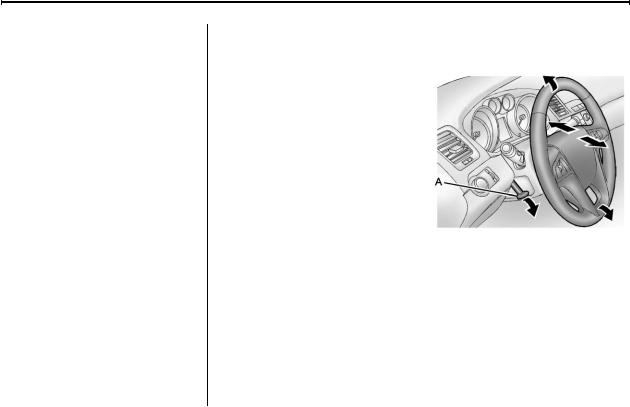
In Brief |
1-11 |
Vehicles with the memory feature can store a preferred mirror position. See “Memory Seats” under Power Seat Adjustment on page 3 5 for more information.
See Power Mirrors on page 2 16.
Manual Foldaway Mirrors
These mirrors can be folded inward to prevent damage when going through an automatic car wash.
To fold, pull the mirror toward the vehicle. Push the mirror outward to return it to the original position.
See Folding Mirrors on page 2 16.
Automatic Dimming Feature
The vehicle may have an automatic dimming driver outside mirror. Automatic dimming reduces the glare of the headlamps behind you.
See Power Mirrors on page 2 16.
Interior
Adjust this mirror for a clear view of the area behind the vehicle. Hold the mirror in the center to move it up, down, or side to side. To reduce headlamp glare from behind, push the tab forward for daytime and pull it for nighttime use.
Vehicles with OnStar® have three control buttons at the bottom of the mirror. See your dealer for more information on the system and how to subscribe to OnStar. See OnStar Overview on page 14 1.
See Manual Rearview Mirror on page 2 17.
Steering Wheel
Adjustment
To adjust the steering wheel:
1.Pull the lever (A) down.
2.Move the steering wheel up or down.
3.Pull or push the steering wheel closer or away from you.
4.Pull the lever (A) up to lock the steering wheel in place.
Do not adjust the steering wheel while driving.

1-12 |
In Brief |
Interior Lighting
Dome Lamps
The interior lamps control located in the overhead console controls both the front and rear interior lamps.
( : Turns the lamps off.
H : Turns the lamps on when any door is opened.
' : Keeps the lamps on all the time.
Reading Lamps
There are front and rear reading lamps.
The front reading lamps are located in the overhead console.
# or $ : Press to turn each lamp on or off.
The rear reading lamps are located in the headliner.
For more information, see:
.Instrument Panel Illumination Control on page 6 6.
.Dome Lamps on page 6 6.
Exterior Lighting
The exterior lamp control is located on the instrument panel on the outboard side of the steering wheel.
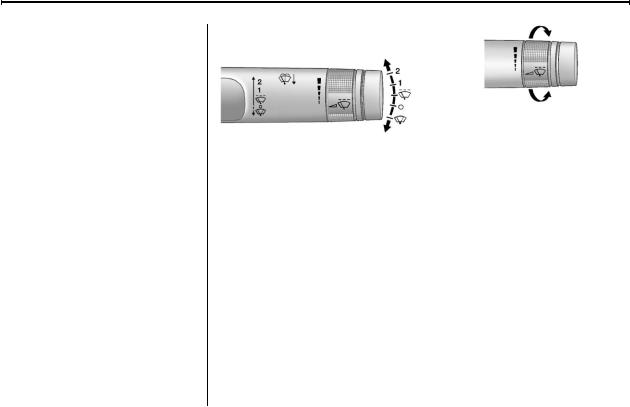
In Brief |
1-13 |
Turn the control to the following positions:
O : Turns off the exterior lamps. The knob returns to the AUTO position after it is released. Turn to off again to reactivate the
AUTO mode.
AUTO: Automatically turns the exterior lamps on and off, depending on outside lighting.
; : Turns on the parking lamps, together with the sidemarker lamps, taillamps, license plate lamps, and instrument panel lights.
2 : Turns on the headlamps, together with the parking lamps, sidemarker lamps, taillamps, license plate lamps, and instrument panel lights.
For more information, see:
.Exterior Lamp Controls on page 6 2.
.Daytime Running Lamps (DRL) on page 6 3.
.Fog Lamps on page 6 5.
Windshield Wiper/Washer
The windshield wiper lever is on the right side of the steering column. With the ignition in ACC/ ACCESSORY or ON/RUN, move the windshield wiper lever to
select the wiper speed.
2: Use for fast wipes.
1: Use for slow wipes.
3 : Turn the band up for more frequent wipes or down for less frequent wipes.
9 : Use to turn the windshield wipers off.
3 : Briefly move the wiper lever down for a single wipe or hold down for several wipes.
Windshield Washer
Pull the windshield wiper lever to spray windshield washer fluid and activate the wipers.
See Windshield Wiper/Washer on page 5 3.

1-14 |
In Brief |
Climate Controls
The heating, cooling, and ventilation for the vehicle can be controlled with these systems.
|
Automatic Climate Control System |
||
A. |
Power |
F. |
AUTO (Automatic Operation) |
B. |
Temperature Control |
G. |
Defrost |
C. |
Fan Control |
H. |
Air Conditioning |
D. |
Air Delivery Mode Control |
I. |
Rear Window Defogger |
E. |
Recirculation |
|
|
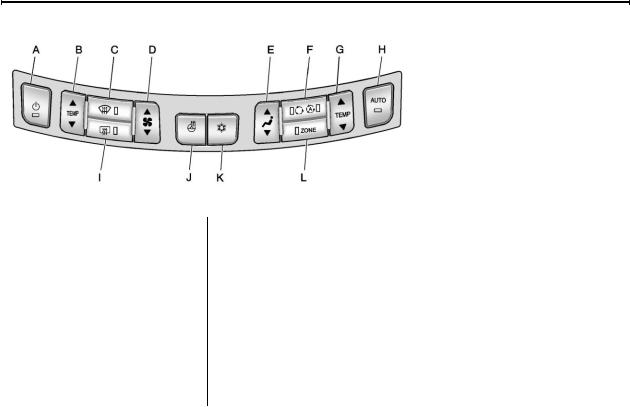
In Brief |
1-15 |
Dual Automatic Climate Control System for Non eAssist Vehicles
A. |
Power |
G. |
Passenger Temperature Control |
B. |
Driver Temperature Control |
H. |
AUTO (Automatic Operation) |
C. |
Defrost |
I. |
Rear Window Defogger |
D. |
Fan Control |
J. |
Heated Steering Wheel |
E. |
Air Delivery Mode Control |
K. |
Air Conditioning |
F. |
Recirculation/Automatic |
L. |
ZONE |
|
Recirculation |
|
|

1-16 |
In Brief |
Dual Automatic Climate Control System for eAssist Vehicles
A. |
Power |
H. |
AUTO (Automatic Operation) |
|
B. |
Driver Temperature Control |
I. |
Rear Window Defogger |
|
C. |
Defrost |
J. |
Eco Air Conditioning |
|
D. |
Fan Control |
K. |
Comfort Air Conditioning |
|
E. |
Air Delivery Mode Control |
L. |
ZONE |
|
F. |
Recirculation/Automatic |
See Automatic Climate Control |
||
|
Recirculation |
System on page 8 1 (If Equipped) or |
||
G. |
Passenger Temperature Control |
Dual Automatic Climate Control |
||
System on page 8 4 (If Equipped). |
||||
|
|
|||
Transmission
Automatic Transmission
Driver Shift Control (DSC)
Driver Shift Control (DSC) allows shifting an automatic transmission similar to a manual transmission. DSC can be enabled through the shift lever. See Manual Mode on page 9 31.

In Brief |
1-17 |
Vehicle Features
Radio(s)
VOL/O : Press to turn the system on and off. Turn to increase or decrease the volume.
SOURCE: Press to choose between FM, AM, or XM™, if equipped.
Menu Knob: Turn to select radio stations.
g : Press to seek the previous station or track.
l : Press to seek the next station or track.
Buttons 1 6: Press to save and select favorite stations.
INFO: Press to show available information about the current station or track.
See Overview (Radio with CD) on page 7 4 or Overview (Radio with CD/DVD and MEM) on page 7 6 or Overview (Radio with CD and Touchscreen) on page 7 8 for more information about these and other radio features.
Storing a Favorite Station
Stations from all bands can be stored in the favorite lists in any order. Up to six stations can be stored in each favorite page and the number of available favorite pages can be set.
To store the station to a position in the list, press the corresponding numeric button 1 to 6 until a beep is heard.
See “Storing a Station as a Favorite” in AM-FM Radio (Radio with CD/DVD/MEM) on page 7 17 or AM-FM Radio (Radio with CD and Touchscreen) on page 7 19
Setting the Clock
Adjusting the Time
1.Press the CONFIG button and select Time and Date.
2.Press + or to increase or decrease hour and minute.
3.To save the time and return to the Time Settings menu, press the / BACK button at any time or press SELECT after adjusting the minutes.
Setting the 12/24 Hour Format
1.Press the CONFIG button and select Time and Date.
2.Press the 12/24 Hour button.
See Clock (With Date Display) on page 5 5 or Clock (Without Date Display) on page 5 6 or Clock (Color Radio) on page 5 6

1-18 |
In Brief |
Satellite Radio
Vehicles with an XM™ satellite radio tuner and a valid XM satellite radio subscription can receive XM programming.
XM Satellite Radio Service
XM is a satellite radio service based in the 48 contiguous United States and 10 Canadian provinces. XM satellite radio has a wide variety of programming and commercial-free music, coast to coast, and in digital-quality sound. A fee is required to receive the XM service.
For more information refer to:
.www.xmradio.com or call 1-800-929-2100 (U.S.).
.www.xmradio.ca or call 1-877-438-9677 (Canada).
For more information, see Satellite Radio on page 7 23.
Portable Audio Devices
Some vehicles have a 3.5 mm (1/8 in) auxiliary input and a USB port located in the center console. External devices such as iPods®, laptop computers, MP3 players, CD changers, and USB storage devices may be connected, depending on the audio system.
For more information, see Auxiliary Devices (Radio with CD) on
page 7 38 or Auxiliary Devices (Radio with CD/DVD and MEM) on page 7 41 or Auxiliary Devices (Radio with CD and Touchscreen) on page 7 44.
Bluetooth®
The Bluetooth system allows users with a Bluetooth-enabled cell phone to make and receive hands-free calls using the vehicle audio system, microphone, and controls.
The Bluetooth-enabled cell phone must be paired with the in-vehicle Bluetooth system before it can be used in the vehicle. Not all phones will support all functions.
See Bluetooth (Overview) on page 7 57 or Bluetooth (Infotainment Controls) on page 7 59 or Bluetooth (Voice Recognition) on page 7 64 or
Bluetooth (UHP Mexico Only) on page 7 70.
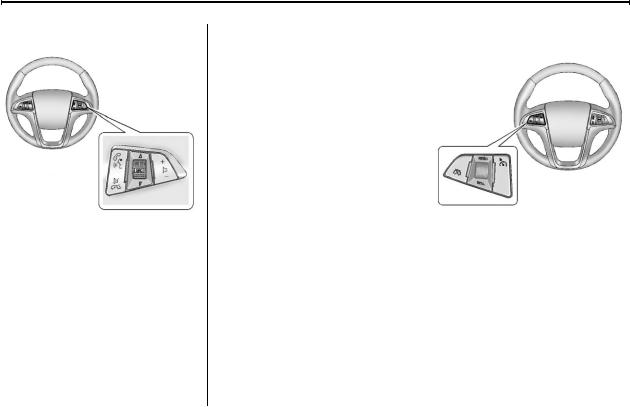
In Brief |
1-19 |
Steering Wheel Controls
For vehicles with audio steering wheel controls, some audio controls can be adjusted at the steering wheel.
b / g : Press to interact with the available Bluetooth, OnStar,
or navigation system.
$ / i : Press to silence the vehicle speakers only. Press again to turn the sound on. For vehicles with OnStar or Bluetooth systems, press to reject an incoming call, or to end a current call.
_ SRC ^ : Turn _ or ^ to select a radio band or audio source.
Turn _ or ^ to select the next or previous favorite radio station, CD, or MP3 track.
Press SRC to change between radio and CD or DVD.
+ x −: Press + to increase or − to decrease the volume.
For more information, see Steering Wheel Controls on page 5 2.
Cruise Control
5 : Press to turn the cruise control system on and off.
* : Press to disengage cruise control without erasing the set speed from memory.

1-20 |
In Brief |
RES/+: Move the thumbwheel up to make the vehicle resume to a previously set speed or to accelerate.
SET/− : Move the thumbwheel down toward SET/- to set a speed and activate cruise control, or to make the vehicle decelerate.
See Cruise Control on page 9 40.
Navigation System
If the vehicle has a navigation system, there is a separate navigation system manual that includes information on the radio, audio players, and navigation system.
The navigation system provides detailed maps of most major freeways and roads. After a destination has been set, the system provides turn-by-turn instructions for reaching the destination. In addition, the system can help locate a variety of points of interest (POIs), such as banks, airports, restaurants, and more.
See the navigation system manual for more information.
Driver Information
Center (DIC)
The DIC display is located in the center of the instrument panel cluster. It shows the status of many vehicle systems. The controls for the DIC are located on the turn signal lever.
A.SET/CLR: Press to set or clear the menu item when it is displayed.
B.w x: Use the thumbwheel to scroll through the items in each menu.
C.MENU: Press to display the Trip/Fuel menu and the Vehicle Information menu. This button is also used to return to or exit the last screen displayed on
the DIC.
For more information, see Driver Information Center (DIC) on page 5 25.

In Brief |
1-21 |
Vehicle Personalization
Some vehicle features can be programmed by using the audio system controls. These features include:
.Climate and Air Quality
.Comfort and Convenience
.Collision/Detection Systems
.Language
.Lighting
.Power Door Locks
.Remote Lock/Unlock
.Return to Factory Settings
See Vehicle Personalization on page 5 40.
Ultrasonic Parking Assist
If available, Ultrasonic Rear Parking Assist (URPA) uses sensors on the rear bumper to detect objects while parking the vehicle. It operates at speeds less than 8 km/h (5 mph).
URPA uses audible beeps to provide distance and system information.
Keep the sensors on the vehicle's rear bumper clean to ensure proper operation.
See Ultrasonic Parking Assist on page 9 42 for more information.
Power Outlets
The accessory power outlets can be used to plug in electrical equipment, such as a cell phone or MP3 player.
There are two accessory power outlets. One is located under the armrest inside the center console storage and the other is on the rear of the center floor console.
Remove the cover to access and replace when not in use.
See Power Outlets on page 5 6.
Universal Remote System
This system provides a way to replace up to three remote control transmitters used to activate devices such as garage door openers, security systems, and home automation devices.
Read the instructions completely before attempting to program the Universal Remote System. Because of the steps involved, it may be helpful to have another person available to assist you with programming the Universal Remote System.
See Universal Remote System on page 5 46.
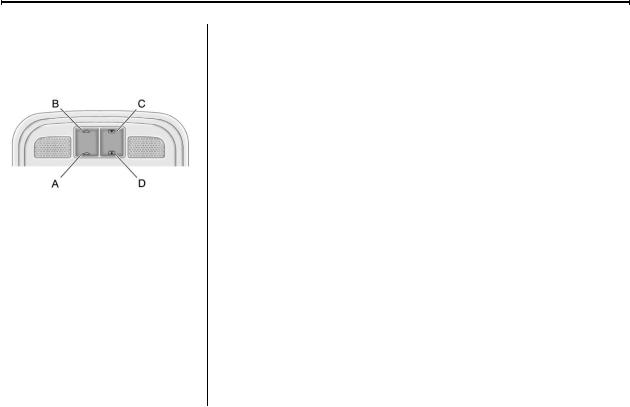
1-22 |
In Brief |
Sunroof
On vehicles with a sunroof, the switches are located on the overhead console.
The ignition must be in ON/RUN or ACC/ACCESSORY, or in Retained Accessory Power (RAP). See
Retained Accessory Power (RAP) on page 9 25.
Vent: Press the rear of the
switch (B) to the first detent to vent the sunroof. Press the front of the switch (A) to the second detent to close the sunroof.
Express-open/Express-close:
To express-open the sunroof, fully press and release the rear of the switch (B). To express-close, fully press and release the front of the switch (A). To stop the sunroof partway, press either switch a second time.
The sunshade opens automatically with the sunroof.
To express-open the sunshade, fully press and release the rear of the switch (C). To stop the sunshade partway, press the switch a second time. To express-close, fully press and release the front of the
switch (D). To stop the sunshade partway, press the switch a second time.
See Sunroof on page 2 21.
eAssist Features
eAssist® Overview
If the vehicle has eAssist, there are several additional features which contribute to increased efficiency.
Vehicles with eAssist have an automatic engine start/stop feature. This feature saves fuel by shutting the engine off when the vehicle is stopped. When the engine shuts off automatically, all the accessories will continue to operate normally. In very hot or cold conditions,
the engine will only shut off automatically part of the time. See
Starting the Engine on page 9 20.
There are two air conditioning settings available. The comfort setting maximizes cabin comfort. The eco setting maximizes the efficiency allowing more frequent, and longer engine stops than the comfort setting. See Dual Automatic Climate Control System on
page 8 4.

In Brief |
1-23 |
This vehicle has a Hill Start Assist (HSA) feature, which may be useful when the vehicle is stopped on a grade. See Hill Start Assist (HSA) on page 9 36.
Vehicles with eAssist have a slightly different instrument cluster, which includes an efficiency gauge, and an AUTO STOP indicator on the tachometer. See Instrument Cluster on page 5 9. There is also a
Power Flow Gauge in the Driver Information Center (DIC). See
Driver Information Center (DIC) on page 5 25.
The eAssist system uses a high voltage battery, which is cooled with air drawn from the vehicle interior.
The cold air intake for the battery is located behind the rear seat, on the filler panel. Do not cover the intake. See Battery on page 10 25.
High Voltage Safety
Information
eAssist vehicles have a standard 12-volt battery and a high voltage battery. Only a trained service technician with the proper knowledge and tools should inspect, test, or replace the high voltage battery. See your dealer if the high voltage battery needs service.
The negative 12-volt battery cable and the high voltage cable in the engine compartment are clearly labeled. In emergency situations, first responders can cut those cables to disable the high voltage battery system.
Driver Efficiency Gauge
This gauge assists the driver in operating the vehicle more efficiently and will vary based on driver input.
See Driver Efficiency Gauge on page 5 12 for more information.

1-24 |
In Brief |
Automatic Engine Start/
Stop Feature
Vehicles with eAssist have an automatic engine start/stop feature. After the engine is started and has reached operating temperature, the auto stop feature may cause the engine to turn off when the brake pedal is applied and the vehicle comes to a complete stop. When the brake pedal is released, or the accelerator pedal is applied, the engine will restart. The engine will continue to run until the next
auto stop.
To restart the engine during the auto stop, release the brake pedal or press the accelerator pedal. The engine starts immediately. The vehicle continues to run until the next stop.
AUTO STOP on the tachometer signifies that the engine is in auto stop mode. See Tachometer on page 5 11 for more information.
A chime will sound when the driver door is opened while in auto stop mode. Remember to shift to P (Park) and turn the ignition to LOCK/OFF before exiting the vehicle.
See Starting the Engine on page 9 20.
Regenerative Braking
Regenerative braking takes some of the energy from the moving vehicle and turns it into electrical energy.
This energy is then stored in the vehicle's high voltage battery system, contributing to increased fuel efficiency.
The system works whenever the accelerator pedal is released, and increases the energy captured as more brake pedal is applied.
Battery
eAssist vehicles have a standard 12-volt battery and a high voltage battery. When a new standard 12-volt battery is needed, see your dealer for one that has the replacement number shown on the original battery's label. Only a trained service technician with the proper knowledge and tools should inspect, test, or replace the high voltage battery. See your dealer if the high voltage battery needs service. See Battery on page 10 25.
